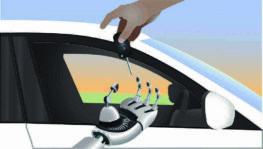
With driver error accounting for a significant portion of motor vehicle accidents in Texas and across the country, auto manufacturers have been working to develop driverless cars, which will transport passengers without any need for human control to guide the vehicle. The thinking goes that removing the element of human error will reduce the number of injuries and deaths from vehicle accidents.
Many newer vehicles on the roads of Texas today have some level of driver assistance. As vehicle manufacturers test new autonomous driving systems, the state of Texas has become notable for having some of the least restrictions on driverless vehicles. Since driverless car technology is still developing, the vehicles do get into accidents on the roads of Texas, potentially causing injury and deaths. The recent crash of a driverless Tesla left two passengers dead. The question is who should be held financially liable when a driverless car causes a crash.
If you’ve been injured by an accident caused by a driverless car or truck, you need an experienced, attorney to help you resolve the complex legal questions in an accident claim involving a driverless vehicle. Turn to the Texas car accident attorneys of Herrman & Herrman, P.L.L.C., for help.
With more than 100 years of combined legal experience, our legal team has the capability to handle complicated personal injury claims. Our attorneys have successfully handled more than 20,000 cases on behalf of our clients. We’re honored by the numerous reviews our clients have left for us on Google, Facebook, and other social media platforms.
Our firm is dedicated to helping you get justice from those at fault for the driverless car accident that injured you. Call Herrman & Herrman, P.L.L.C., today at (361) 882-4357 or contact us online for a free case evaluation. Learn more about how our firm can help you hold other parties liable after you’ve been injured in a driverless car accident in Texas.
News About Accidents Involving Driverless Cars
Driverless and self-driving cars have been responsible for causing injury and death to residents of Texas. In April 2021, a 2019 Tesla Model S was involved in a single-vehicle accident in The Woodlands, a suburb of Houston. The Tesla veered off the road after taking a turn at too high a speed, colliding into a tree and bursting into flames. After putting out the fire, police found that neither of the two deceased occupants was driving the vehicle. One occupant was seated in the front passenger seat and the other was sitting in the rear seat.
Auto manufacturer Tesla has been one of the pioneers in the development of self-driving vehicles. The manufacturer includes a suite of technology in its vehicles that it has marketed as “Autopilot.” Tesla has come under criticism by safety advocates who claim that the self-driving technology in Tesla vehicles has not been sufficiently tested for use on public roads and that the company misleads consumers as to the capability of Tesla vehicles’ self-driving technology.
Although Autopilot allows Tesla vehicles to accelerate, brake, and steer on their own in certain circumstances, the feature requires drivers to maintain supervision of the vehicle and the road so that they can intervene and take manual control of the vehicle when necessary. But as drivers have become more comfortable with the technology, they have become less attentive to the task of driving while behind the wheel.
Tesla CEO Elon Musk announced that data from the recent accident outside of Houston indicated that the vehicle involved did not have the most advanced driver assistance features offered by the company and that the vehicle’s Autopilot function did not appear to have been engaged at the time of the crash.
How Do Driverless Cars Work?
A driverless car uses various sensors attached to the vehicle, such as cameras, ultrasound, and radar or lidar to guide the vehicle. The steering systems allow vehicles to create a map of their surroundings, monitoring nearby vehicles and pedestrians, traffic signals, lane markings, and road signs. The vehicle’s computer processes the input from the sensors to plot the car’s movement. Driverless cars are usually programmed with object recognition, predictive modeling, and hard rules to help the vehicle follow traffic laws and navigate obstacles on the road.
Driverless vehicle technology is categorized according to the level of automation the system provides. The Society of Automotive Engineers defines six levels of driving automation, ranging from Level 0, or full manual driver control, to Level 5, or fully autonomous control. Levels 0 through 2 require a human to monitor the driving environment, while systems in Levels 3 through 5 take over monitoring the environment.
Some vehicles manufactured today have Level 3 automation, or conditional automation where the system can only be used under certain circumstances, or Level 4 automation where the system can be used in a much wider set of circumstances. However, both Level 3 and 4 automation systems are subject to the requirement that a driver supervises the operation of the vehicle to intervene when necessary.
In Level 5 automation, a vehicle would be considered fully autonomous, able to tackle any driving situation, without the need for a driver to maintain attention and supervision of the vehicle.
Who Is Liable in a Driverless Car Accident in Texas?
When a driverless car is involved in a motor vehicle accident, it can raise the question of who can be held liable for the crash. Can the occupant in the driver’s seat be held responsible for an accident when he or she was not actively operating the vehicle at the time of the crash?
Liability for a driverless car accident in Texas may depend on several factors
Human Error
Most driverless cars still require driver supervision when the autonomous function of the vehicle is engaged. Drivers are expected to intervene and take manual control of the vehicle if the vehicle begins performing unusual or inappropriate maneuvers – for example, failing to slow when approaching slowed or stopped traffic, or attempting to move into another lane occupied by another vehicle.
Many driverless and self-driving vehicle accidents have been attributed to the autonomous technology of the vehicle failing to perform properly and the driver of the vehicle not recognizing the need to take manual control of the vehicle. When a driver’s erroneous management of a vehicle’s autonomous driving functions contributes to an accident, the driver may be held liable for the crash.
Vehicle Malfunction
Self-driving technology remains under development. Inevitably autonomous driving technology in a vehicle may fail for one reason or another, including the vehicle’s sensors malfunctioning, or the computer that controls the autonomous function experiencing an error. When an accident is caused by a driverless car suffering from a software malfunction or mechanical malfunction, the vehicle’s manufacturer may have liability for the crash.
Inadequate Regulatory Oversight
State and federal governments have the responsibility for regulating the testing of driverless vehicles on public roads.
Governments should only allow experimental vehicles onto public roads where manufacturers have demonstrated that conducting testing on public roads will not put the motoring public at unreasonable risk of harm.
Defective Design or Manufacturing
Driverless cars may get into an accident due to a design or manufacturing defect with the equipment that makes up the self-driving system. If a driverless vehicle is found to have a defect, the vehicle’s manufacturer may be held liable under product liability laws for injuries and losses from an accident caused by that driverless vehicle.
Currently, no commercially available vehicle can operate on the road without some level of driver supervision and control over the vehicle. But the introduction of autonomous vehicles to Texas roads and highways will raise complex questions of liability. Vehicle automation is an evolving area of product liability law.
When a self-driving car is found to have caused a motor vehicle accident, the driver of the vehicle will still most likely be held liable for injuries and losses that the victims of the accident suffer, with the driver’s insurance coverage paying for those losses.
Contact a Car Accident Attorney Today
If you’ve been injured in an accident involving a self-driving car, you may be entitled to seek financial compensation from the at-fault driver or the manufacturer. Contact Herrman & Herrman, P.L.L.C., or call us at (361) 882-4357 today for a free, no-obligation consultation with a Texas car accident attorney. Learn about your legal options for holding parties accountable for the harm and losses that you’ve suffered.
We have a bilingual, English- and Spanish-speaking staff and office locations in Corpus Christi, McAllen, San Antonio, and Brownsville to serve you.








